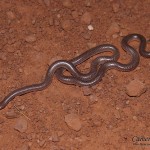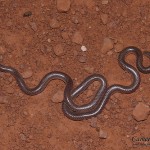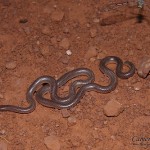Western Blind Snake (Leptotyphlops humilis)
At first glance, a blind snake might resemble a worm more than a snake. Tiny, slim snakes, one can be described as nothing more than a neck-less, blunt head on a slender cylindrical body ending in a short, rounded tail bearing a tiny spur on its tip. Rarely measuring more than 10 inches long and no wider than a shoelace, they are purplish, browngray or pink above and lighter below. A closer look in good light reveals a silvery sheen of smooth, tightly overlapping, hexagonal-shaped scales. Tiny vestigial eyes appearing as dark spots below ocular scales serve merely to perceive light. Blind snakes belong to a family of snakes called the Leptotyphlopida, or slender blind snakes. Matching their description, the scientific name of blind snakes comes directly from the Greek words leptos, meaning slender, tuphlos, meaning blind, and ops, meaning eye. In common vernacular, they are also called thread snakes or worm snakes.
The Latin word humilis means small or ground-dwelling and reflects the subterranean lifestyle of these snakes. Blind snakes burrow underground among roots and beneath rocks, sometimes jabbing the spur on their tail into tunnel walls for leverage while moving through the soil. Their skulls are also more solidly fused than those of most other snakes to help them push through soil. Seldom seen because they are fossorial and nocturnal, people sometimes encounter blind snakes while excavating foundations, digging ditches or post holes, or gardening. Sometimes they are also brought home as a gift by the family cat. Although they spend much of their lives underground, they also roam the surface at night or around dusk during the summer months, especially after rainstorms.
Considered among the most primitive of snakes, slender blind snakes retain tiny remnants of pelvic bones embedded in their muscles as well as rudimentary femur bones. They have teeth only in their lower jaw and the scales on their underside are not elongated, but are the same shape and size as the rest of their scales. They retain so many primitive features that some herpetologists have suggested they be reclassified into their own group separate from other snakes. Though considered primitive, they also exhibit many specializations and a relatively high degree of diversification among species.
The subspecies unique to Utah, the western blind snake (L. h. utahensis) was officially described by Vasco M. Tanner in 1938. This subspecies ranges from west Texas to extreme southwestern Utah. Restricted to the Mojave Desert portions of Washington County in Utah, they occur in a variety of brush-covered habitats at elevations between 2,500 and 4,000 feet. Here they frequent rocky hillsides with patches of loose, moist soil suitable for burrowing and canyon washes near streams.
Blind snakes feed upon soft-bodied insects, especially ants and termites and their eggs and larvae. They locate colonies of ants and termites by following pheromone trails left by these insects. To fend off biting ants, blind snakes can tilt and angle individual scales to make it harder for ants to get a grip with their jaws. Foul smelling secretions from cloacal scent glands found in blind snakes aid in repelling attacking ants as well. Their cloacal discharge may serve to deter predators as well. When captured, a blind snake will writhe wildly, poke with its spur and discharge the contents of its glands. Though harmless, the odor and spur may startle a predator and allow the snake to make an escape.
Blind snakes mate in spring. In late summer the females lay 2 to 6 slender, tiny 5/8 inch long eggs in protected underground nurseries. Sometimes they nest communally. The eggs are tended until after the 3½ inch long hatchlings emerge from their eggs.
Despite what is known about these truly unique snakes, other aspects of their life history, including details of their annual activity cycles, longevity, limits of their ranges and evolutionary history, remain an enigma. If you ever see one of these, tiny creatures, now you’ll know it’s a blind snake and not an earthworm.
http://wildlife.utah.gov/education/newsletters/03winter-gw.pdf


